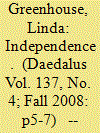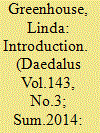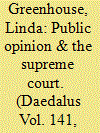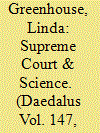|
|
|
Sort Order |
|
|
|
Items / Page
|
|
|
|
|
|
|
| Srl | Item |
| 1 |
ID:
084778


|
|
|
| 2 |
ID:
132743


|
|
|
|
|
| Publication |
2014.
|
| Summary/Abstract |
This volume is both prequel and sequel. In 2008, Dædalus published an issue entitled "On Judicial Independence," exploring from a variety of perspectives the de½nition of that term, as well as ageold
and newly emergent threats to the ability of judges to do their work without undue constraint. Six years later, we both carry that story forward and shift the analytical frame to consider courts them selves: their past and ongoing evolution, and the work that a democracy can reasonably expect them to do. To write about courts is to write about political theory, about lawyering, about ½scal priorities, and about social welfare, as well as about courts' dependence on and independence from the body politic. The subject evokes a great variety of conversations, from the highly theoretical to the nitty gritty of service delivery for human needs in all their man - ifestations. Discussions of courts, at least in the United States, bring lawyers rapidly into view, along with criminal defendants, civil litigants, administrative agencies, budgets, public ½nancing, and popular opinion.
|
|
|
|
|
|
|
|
|
|
|
|
|
|
|
|
| 3 |
ID:
121025


|
|
|
|
|
| Publication |
2012.
|
| Summary/Abstract |
The relationship between the Supreme Court and public opinion remains ambiguous, despite efforts over many years by scholars both of the Court and of mass behavior to decipher it. Certainly Supreme Court Justices live in the world, and are propelled by the political system to their life-tenured positions. And certainly the Court, over time, appears to align itself with the broadly defined public mood. But the mechanism by which this occurs-the process by which the Court and the public engage one another in a highly attenuated dialogue-remains obscure. The Court's 1973 abortion decision, Roe v. Wade, offers a case in point. As the country began to reconsider the wisdom of the nineteenth-century criminalization of abortion, which voices did the Justices hear and to which did they respond? Probing beneath the surface of the public response to Roe serves to highlight rather than solve the puzzle.
|
|
|
|
|
|
|
|
|
|
|
|
|
|
|
|
| 4 |
ID:
161747


|
|
|
|
|
| Summary/Abstract |
When it comes to science and technology, Supreme Court justices resemble lay people in robes, often ill-equipped to grasp fully the implications of the important cases they are asked to decide on scientific subjects. The justices approach science not in the abstract, of course, but from within the doctrinal area in which the particular dispute arises, whether intellectual property, criminal law, or the First Amendment's protection of free speech. The Supreme Court's abortion jurisprudence offers a particularly interesting and consequential example of the Court's encounter with science: a prolonged encounter, since from the beginning, the Court viewed women's claim to reproductive freedom through a medicalized lens. In recent years, states wishing to curb access to abortion have claimed health justifications for placing novel and onerous restrictions on abortion providers. In Whole Woman's Health v. Hellerstedt, decided in June 2016, the Court invalidated one such effort, a Texas law, on the ground that the claimed health benefits were insufficient to justify the predictably massive shrinkage of the medical infrastructure necessary for women to be able to exercise their constitutional right to terminate a pregnancy. Evidence-based law met evidence-based medicine in a decision that demonstrated a new willingness by the Court to insist on good science in the area of abortion, and perhaps beyond.
|
|
|
|
|
|
|
|
|
|
|
|
|
|
|
|
|
|
|
|
|